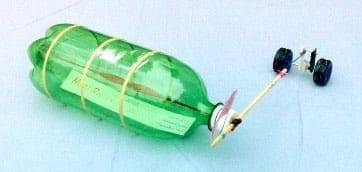Mars Roller

| Race Order |
Entry # | Driver Name | Car Name | Mass (grams) |
Length (inches) |
Width (inches) |
Height (inches) |
Distance Traveled (feet) |
Running Time (seconds) |
Awards |
| 11 | 44 | Hong Yuan | Mars Roller | 92 | 11.5 | 12 | 3.75 | 21.08 | 15.17 | Most Unusual |
Balloon car designer Hong Yuan writes:
- Design approach taken – explain how it worked.
The idea is simple. The balloons are used as a rubber band. When
the rubber band is stretched and twisted, the untwisting force rolls a
two-liter soda bottle, hence, the name “Mars Roller”.I made two holes on the soda bottle, one at the center of the bottom
and one at the center of the cap. One end of the balloon band was
secured to the bottom of the bottle; the other end came out of the cap
and was fixed on a chopstick. After the balloon band is wound up, lay
the bottle on the ground, the chopstick is “stuck”, the untwisting force
can only roll the bottle, which then moves forward. - Unique or clever features embodied
To create appropriate attraction on the cement runway, yet not to
increase the mass of the vehicle dramatically, I wrapped three rubber
bands around the bottle.To “steer” the vehicle, one end of the chopstick was wired with a
pair of wheels. The bottle rolled with stability in a straight line. - Materials of construction (mention unique parts you used or fabricated)
A two-liter soda bottle (found in a trash can), a chopstick, a
pair of wheels taken apart from a toy car that costs $2.90, three rubber
bands, paperclip, wire, superglue, string. - Reasons behind any significant design choices you had to make
I tried slicing the balloons to make an elastic rubber band, but it
did not seem to provide as much force as with the balloon intact. I
first superglued the bottoms of the two balloons, then wreathed the
connection with string. I used a paperclip to secure one end of the
balloon band, and stuck the other straightened end of the paperclip in a
third tiny hole on the bottle near the center hole so that that end of
the balloon band became one with the bottle.Having the two wheels in front was crucial to steering the vehicle,
as I soon learned. I initially had the chopstick trailing the car (one
end of it touched the ground); and I thought I could adjust the position
of the rubber bands around the bottle to make it go straight. That
simply did not work; the car curved with the chopstick lagging behind.
When the twisted balloon band releases energy, the untwisting force
exerts on the bottom of the bottle, making it roll faster than the top
of the bottle. It could go no more than 10 feet distance although its
actual path was longer. I thought I might be stuck with my design
because there was no time left to make any improvements.At about 10:30pm of the night before the contest, I called Target in
Pasadena and was told it would be open till 11:00pm. I immediately
drove there and bought a toy car for $2.90. I broke the car apart and
wired the pair of wheels to the chopstick. I then made a little flag
with NASA and JPL logos and placed it on the other end of the chopstick.
My Mars Roller was ready to roll. It rolled 20 feet STRAIGHT, with
ease, on a trial run at 2:30am on the day of the contest. - Lessons learned (what you’d do differently next time)
Use ball bearings on the wheels and the loose connection between the
bottle and the chopstick. The latter is tricky, but I have given it
some thought and have some ideas. - Anything else you’d like to add
I entered the contest at the last minute of the deadline (3 days
before the contest) and worked two nights to fabricate my entry. Unlike
my other software projects, this project was completed on schedule (10
hours) and within budget (< $4.00).With Glenn Beardsley of Uncle Milton Industries and Steve Pennington
of the Mattel Corporation being the judges, my Mars Roller, the 8th in
running distance, won the “Most Unusual Design Award” (I call it the
“Most Distinctive Design”). I became a “celebrity” on The Pasadena Star
News published on Saturday, December 1998 that had a large picture of me
winding up my Mars Roller getting ready for the race. That was most
rewarding for a software engineer who had not done a “hardware” project
like this for a long time. I have added a copy of the video tape
recording of the contest to my video collection. Mars Roller, along
with the nicely framed Award Certificate, is now on display in my office
for free viewing.Thanks to Paul MacNeal who came up with the idea and organized the
event and to all those who made the event such a success. It was a lot
of fun and a great way to end the year 1998.
MB 1/9/99e